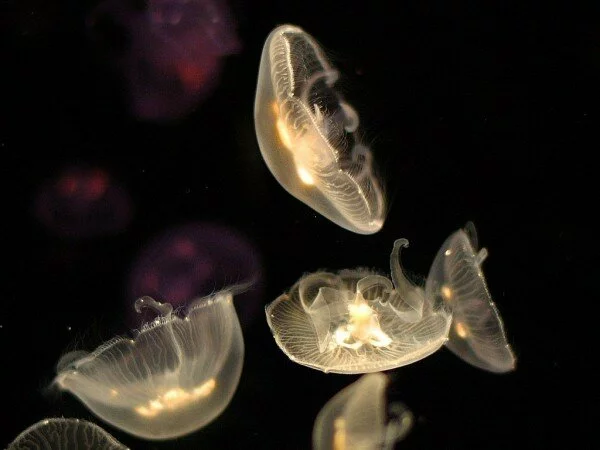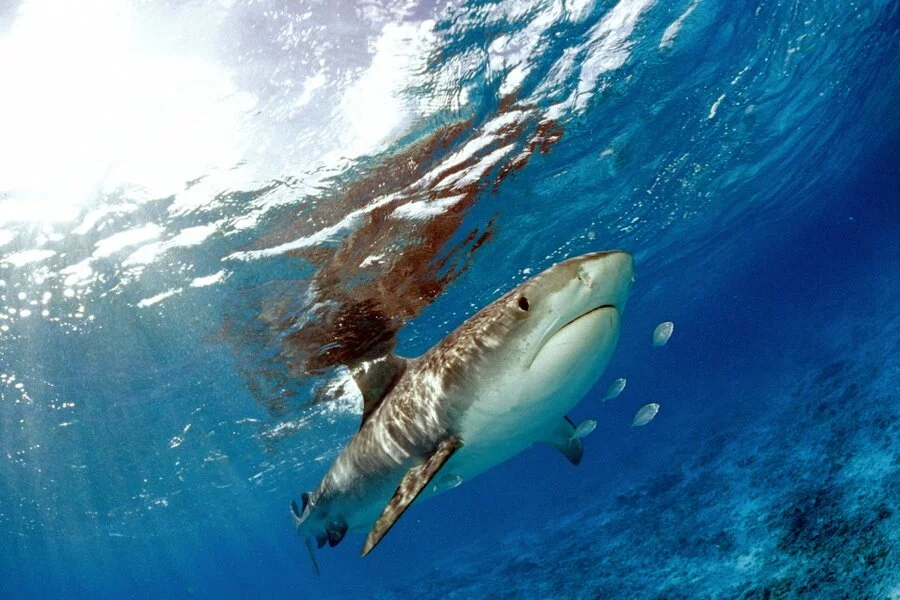Earth’s Alien World: Life in the Deep Ocean
For humans, the ocean has long been a realm of both intrigue and intimidation. It captivates our minds with its beauty and mystery, yet also humbles even the strongest men with its power and, sometimes, merciless nature. For long, we have relied on it for our survival, yet countless have perished in its waters. It is not difficult to understand why humans share this unusual connection with the ocean. We are, after all, physically designed for an entirely terrestrial lifestyle. In fact, even the greatest of human swimmers seem clumsy in comparison to aquatic animals (and even many terrestrial animals) when in the water. As a result, an environment such as the open ocean, though beautiful and inspiring, could easily make many of us feel vulnerable and helpless. However, the ocean’s attractive qualities often rival this fear. This is probably due to the fact that the ocean itself contains a great world vastly different from ours. Below the surface exists a massive realm which far exceeds our terrestrial home in variety and size. Complex ecosystems and countless unique species can be observed throughout the great expanses of water which make up the majority of the earth’s surface. The seemingly endless resources available from the ocean are primarily why humans have long maintained their connection with the seas ever since they first discovered them. Throughout the generations, our knowledge and appreciation of the oceans have grown as we continue to discover more of the marine realm’s secrets. Yet, even today, we must acknowledge that we still know little about this world, for much of what we do know about the ocean consists of information concerning its surface. The waters housing seals, marine birds, colorful fish of many varieties, dolphins, and other well known animals are but a small fraction of the ocean. In reality, the ocean conceals a world much more massive than that which we are familiar with, a zone which seems more like outer space than a true ecosystem. Dark, frigid, and hidden under vast, crushing volumes of water, this alien range has developed with little to no interaction with the surface environments. It is almost disconnected with the events of the upper oceanic layers, and the fantastic forms of life present here, though relatively rare, will truly shock you.
The oceans possess a variety of different environments due to their massive size and depths. As a result, it is important to understand their divisions. There are two broad realms present in the oceans, the pelagic and the benthic. The pelagic zone is the open water in which swimming and floating species (generally known as pelages) occur. Since the oceans are so deep, the pelagic zone must be divided into more specific zones as well. The epipelagic zone is the uppermost level and is observed in depths less than 200 meters. Since sunlight easily reaches into this zone, photosynthesis can take place in the epipelagic division. Below the epipelagic exists the mesopelagic zone, which is observed in depths of 200-1000 meters. Known as the “twilight” zone, the faint presence of sunlight in this area is not sufficient for the process of photosynthesis. The bathypelagic zone contains no sunlight whatsoever and can be observed 1000-4000 meters below the surface, followed by the abyssopelagic at depths of 4000-6000 meters. The deepest level of all is the frigid hadopelagic zone, which consists of deep trenches that can drop anywhere from more than 6000 meters to nearly 11,000 meters in depth.[1]
Meanwhile, the benthic zones are defined as the bottom sediments and other surfaces of a body of water such as an ocean or a lake. The species present in these zones, known as benthos, live in close relationship with the bottom of the sea, as many of them are attached to it, some are often burrowed in it, and others swim just above it. The benthic zones of oceanic habitats are categorized by depths corresponding to the comparable pelagic zones. First is the intertidal zone, which has no pelagic counterpart. This is the zone where sea meets land, ending in the beaches that humans often enjoy traveling to. This is followed by the subtidal zone, which drops to a depth of about 200 meters.[2] It contains the continental shelves, which are basically the submerged portions of the continents.[3] This continues into the bathyal zone, which lies up to 4000 meters below the water’s surface.[4] This zone contains the continental slopes, steep drops which carry on from where the continental shelves conclude.[5] Most of the deep ocean seafloor, known as the deep ocean basin, is part of the abyssal zone, which plunges down to depths of 4000-6000 meters. Finally, the deep tranches of the hadal zone mark the lowest points on the seafloor, reaching almost 11,000 meters.[6]
The deeper zones are quite interesting in that their features are different from what some might expect. The deep ocean basin’s geography is actually quite similar to the features observed on land, though on a much greater scale. From extensive plains to massive mountains, the deep ocean floor may very well seem like a submerged version of our world (only without light and in an extreme cold state). In fact, the earth’s longest mountain range is located below the sea. At over 35,000 miles in length, this incredible mountain range, known as the Mid-Ocean Ridge system, snakes its way around the globe.[7] Furthermore, the deeper benthic zones consist of mud or a form of “ooze” (mud with a high percentage of organic remains) due to the accumulation of pelagic organisms which sink to deeper levels after they die. Sandy habitats are scarce in the deep sea because sand particles, which are created by wave action on coral and rocks at shorelines, are too heavy to be carried by currents to the deep. Benthic areas which are too deep for sediment to stick are instead rocky. These rocky areas can be found on the flanks of islands, seamounts, and rocky banks, as well as on mid-ocean ridges and their rift valleys and some parts of continental slopes. At mid-ocean ridges, where magma often wells up and pushes seafloor tectonic plates apart, even flat surfaces are rocky because they are geologically too new to have accumulated much mud or ooze (as one might expect from these deep areas). There are also unique benthic zones where chemical reactions produce some rather unusual formations. These areas may be relatively rare, but they contain some of the most fascinating species communities in the ocean deep.[8]
The living conditions in the deeper ocean levels are truly extreme. In fact, it was long considered that the oceanic depths were simply too harsh to support any life. As a result, the marine world’s icy, dark realms remained unexplored until the 19th century, when European scientists first began to probe the depths of the North Atlantic for any signs of life. Initial sampling suggested that animals did, indeed, inhabit the deeper waters. These fascinating new ideas soon led to the beginnings of modern oceanography when, in response to the samplings, the H.M.S. challenger was commissioned for a great expedition around the world that lasted from 1872 to 1876.[9] The purpose of this grand new journey was to gather data on a wide range of ocean features, including ocean temperatures, seawater chemistry, currents, seafloor geology, and, of course, marine life. The H.M.S. Challenger itself was originally a British Navy corvette (a small warship) which was converted into the first dedicated oceanographic ship complete with its own laboratories, microscopes, and other scientific equipment on board. Leading the expedition were British naturalist John Murray and Scottish naturalist Charles Wyville Thompson. Thompson was among the scientists who dredged interesting new creatures from the ocean depths in the North Atlantic and the Mediterranean Sea, discoveries which persuaded the British government to launch the worldwide Challenger expedition. The Challenger left Portsmouth, England just before the Christmas of 1872. It was well prepared for the crew’s objectives, as the ship contained several different types of samplers to grab rocks or mud from the ocean floor, as well as nets to capture animals from different levels in the ocean. Challenger also had different winches, mechanical engines which were used to lower and hoist sounding lines to measure how deep the currently inhabited waters were. At each sampling station, the crew lowered trawls, nets, and other samplers at several different depths, from the surface down to the seafloor, and then pulled them back onboard where they were able to observe the variety of animals and rocks they acquired.[10]
With the tools needed to study the contents of the ocean deep in hand, the crew of the H.M.S. Challenger first traveled south from England to the South Atlantic, and then around the Cape of Good Hope at Africa’s southern tip. From there, the Challenger sailed across the wide and violent seas of the southern Indian Ocean, crossing the Antarctic Circle, and then to Australia and New Zealand. After this, the crew ventured north to the Hawaiian Islands and then south again around Cape Horn, South America’s southern tip where the Atlantic and Pacific Oceans meet. After further exploration of the Atlantic Ocean, the H.M.S. Challenger returned to England in May of 1876. Many great discoveries were made in this 68,890 mile-long expedition. Among these discoveries was one of the deepest parts of the ocean, the Marianas Trench in the western Pacific, where the seafloor is 26,850 feet below the water’s surface (the deepest point in all the oceans, named the Challenger Deep, is actually near where the crew took its sounding and is 37,800 feet deep). This expedition also revealed the first broad outline of the shape of the ocean basin, including the rise in the middle of the Atlantic Ocean that we now know as the Mid-Atlantic Ridge. The crew was also able to capture and study up to 4700 new species of plants and animals throughout these travels. It is no surprise that with these incredible new observations, the Challenger Expedition encouraged other countries to take interest in the oceans and mount expeditions of their own.[11]



